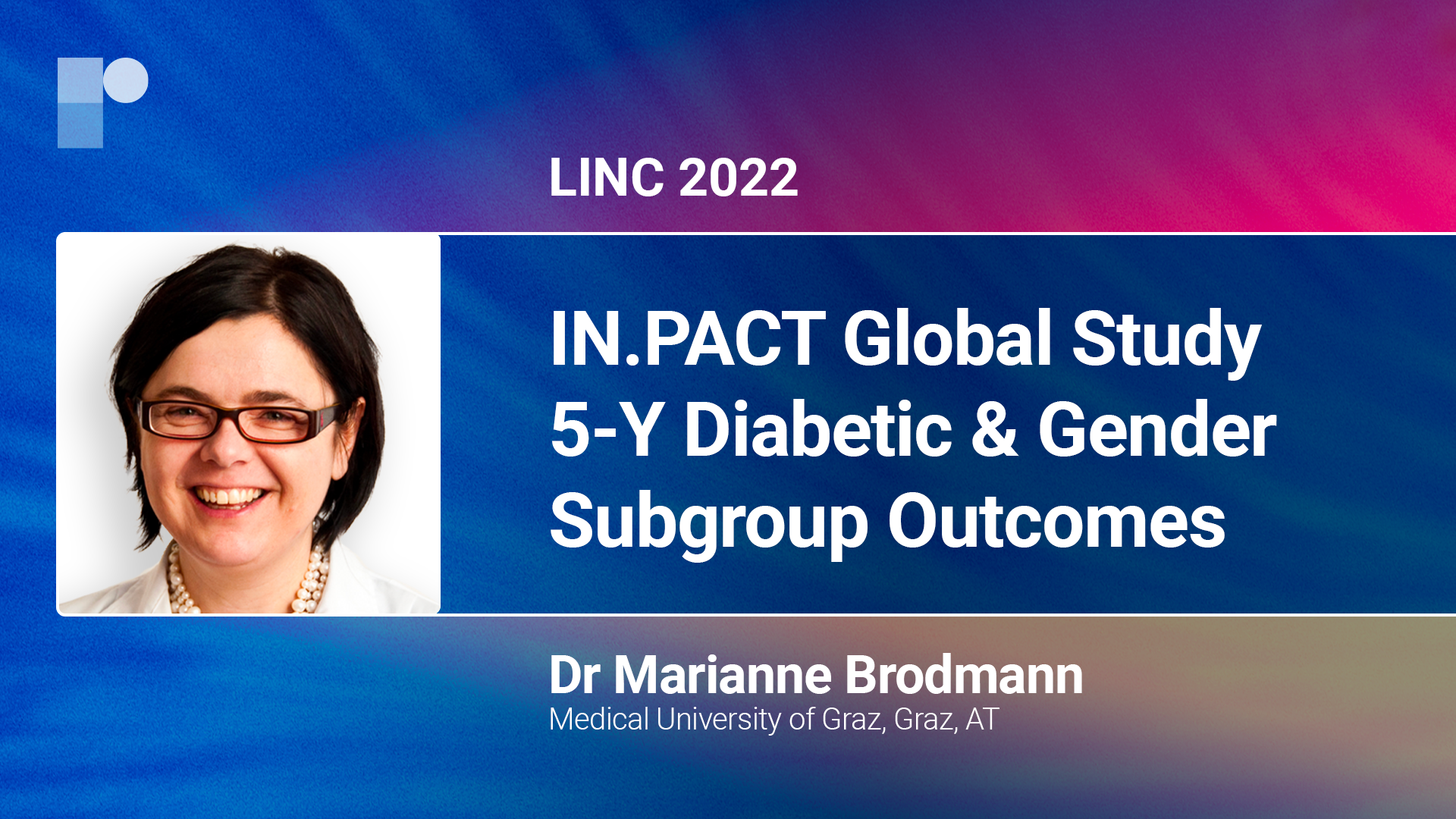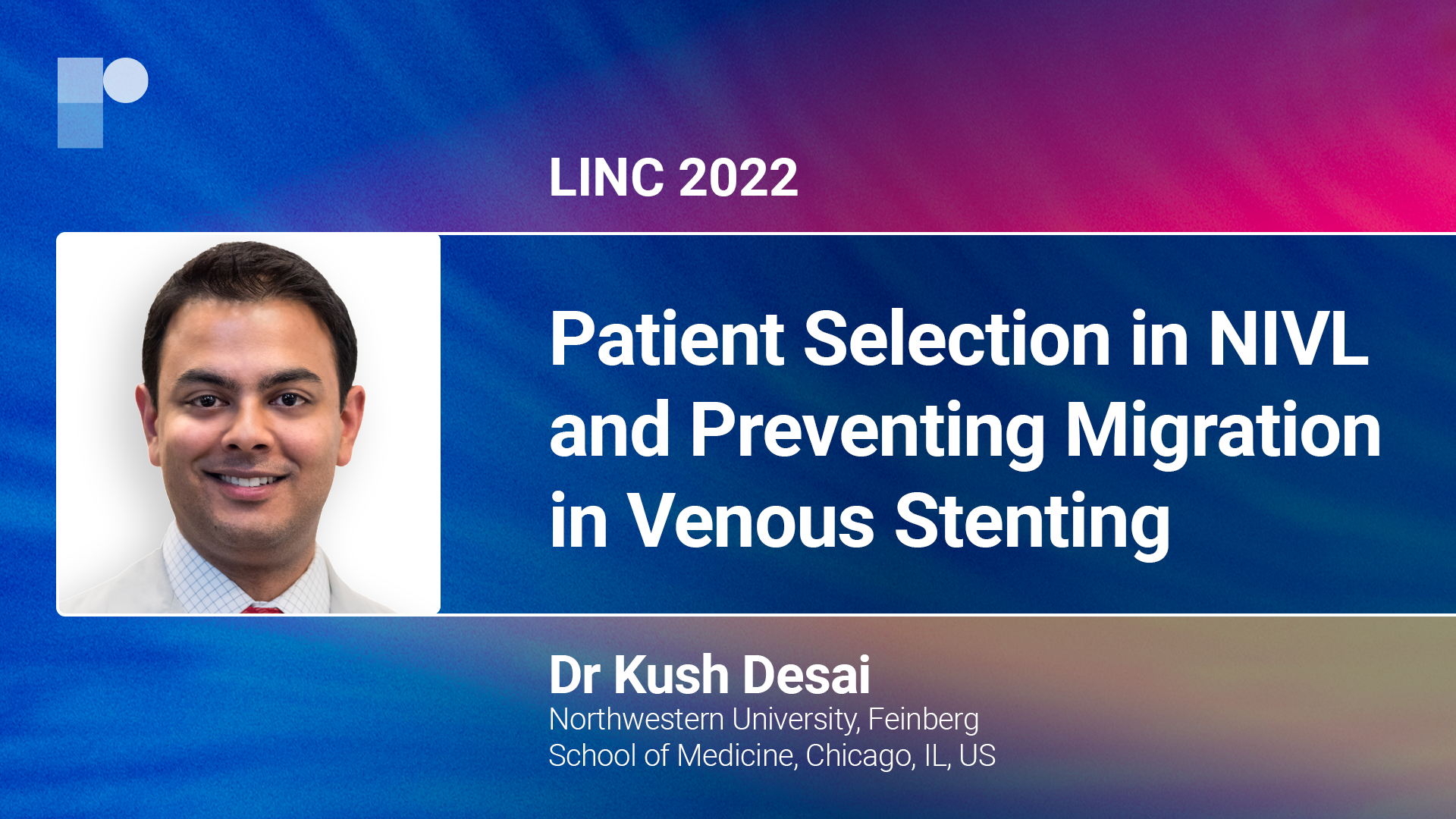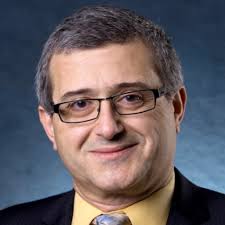LINC 2022: Late-breaking Science Video Collection
Published: 14 June 2022
-
Views:
 2969
2969
-
Likes:
 7
7
-
Views:
 2969
2969
-
Likes:
 7
7
-
 Up Next
Up Next -
 5m 32sPart 1 | Session 11 JET-RANGER: Jetstream Atherectomy & DCB In Pts With Complex Calcified Lesions
5m 32sPart 1 | Session 11 JET-RANGER: Jetstream Atherectomy & DCB In Pts With Complex Calcified Lesions -
 5m 43sPart 1 | Session 12 FLEX RCT: Micro-Incision prior to PTA in Pts With AVF
5m 43sPart 1 | Session 12 FLEX RCT: Micro-Incision prior to PTA in Pts With AVF -
 2m 46sPart 1 | Session 13 BioMimics 3D Stent: Safety and Efficacy in Real-World Patients
2m 46sPart 1 | Session 13 BioMimics 3D Stent: Safety and Efficacy in Real-World Patients -
 2m 44sPart 1 | Session 14 P-MAX Study with Dr Lichtenberg: ASPIREX®S Endovascular System
2m 44sPart 1 | Session 14 P-MAX Study with Dr Lichtenberg: ASPIREX®S Endovascular System -
 2m 15sPart 1 | Session 15 Cost-Effectiveness of Urea Excipient-Based DCBs for CLTI
2m 15sPart 1 | Session 15 Cost-Effectiveness of Urea Excipient-Based DCBs for CLTI -
 7m 57sPart 1 | Session 16 The CLariTI Study: Natural Progression of CLTI
7m 57sPart 1 | Session 16 The CLariTI Study: Natural Progression of CLTI -
 4m 19sPart 1 | Session 17 PAD in Germany 2009-2018 With Dr Rammos
4m 19sPart 1 | Session 17 PAD in Germany 2009-2018 With Dr Rammos -
 3m 26sPart 1 | Session 18 LINC 22: IN.PACT Global Study 5-Y Diabetic & Gender Subgroup Outcomes
3m 26sPart 1 | Session 18 LINC 22: IN.PACT Global Study 5-Y Diabetic & Gender Subgroup Outcomes -
 5m 20sPart 1 | Session 19 Patient Selection in NIVL and Preventing Migration in Venous Stenting
5m 20sPart 1 | Session 19 Patient Selection in NIVL and Preventing Migration in Venous Stenting
-
 4m 28sPart 1 | Session 1 GPX Embolic Device In Peripheral Applications Andrew Holden
4m 28sPart 1 | Session 1 GPX Embolic Device In Peripheral Applications Andrew Holden
-
 5m 32sPart 1 | Session 2 B-CLEAR Registry: Timing of TEVAR in Type B Aortic Dissection Erin Saricilar
5m 32sPart 1 | Session 2 B-CLEAR Registry: Timing of TEVAR in Type B Aortic Dissection Erin Saricilar
-
 4m 16sPart 1 | Session 3 Endovascular Angiography in Pts With Diabetic Foot Ulcers Using the Angiosome Model Erin Saricilar
4m 16sPart 1 | Session 3 Endovascular Angiography in Pts With Diabetic Foot Ulcers Using the Angiosome Model Erin Saricilar
-
 3m 58sPart 1 | Session 4 Cre8™ BTK Clinical Results in Complex BTK Patients Marc Sirvent
3m 58sPart 1 | Session 4 Cre8™ BTK Clinical Results in Complex BTK Patients Marc Sirvent
-
 4m 25sPart 1 | Session 5 AVF Formation with Adjuvant Endovascular Maturation Shannon Thomas
4m 25sPart 1 | Session 5 AVF Formation with Adjuvant Endovascular Maturation Shannon Thomas
-
 6m 16sPart 1 | Session 6 Long-Term Results of Supera in AVF Junta-Anastomosis Shannon Thomas
6m 16sPart 1 | Session 6 Long-Term Results of Supera in AVF Junta-Anastomosis Shannon Thomas
-
 6m 42sPart 1 | Session 7 SirPAD RCT: Sirolimus-Coated DCBs in Pts with PAD Stefano Barco
6m 42sPart 1 | Session 7 SirPAD RCT: Sirolimus-Coated DCBs in Pts with PAD Stefano Barco
-
 2m 39sPart 1 | Session 8 PRELUDE-BTK With Dr Lichtenberg: Serranator® PTA in Pts With PAD Michael Lichtenberg
2m 39sPart 1 | Session 8 PRELUDE-BTK With Dr Lichtenberg: Serranator® PTA in Pts With PAD Michael Lichtenberg
-
 4m 46sPart 1 | Session 9 PRIZER Study: Renzan™ Stent in Pts With PAD Koen Deloose
4m 46sPart 1 | Session 9 PRIZER Study: Renzan™ Stent in Pts With PAD Koen Deloose
Overview
Short, accessible Expert Interviews will be available with select faculty focusing on the results, applicability, and impact on future research.
More from this programme
Part 1
Expert Interviews
Faculty Biographies

Nicholas W Shammas
Founder and Research Director
Dr Nicolas W Shammas, MD, MS, EJD, FACC, FACP, FCCP, FSCAI, received his combined Master of Science-Doctor of Medicine (MS-MD) degrees at the American University of Beirut, Lebanon and Internal Medicine Residency at the University of Iowa Hospitals & his Cardiology Fellowship at the University of Rochester Medical Center, Rochester, NY in 1994. He returned to the University of Iowa, Division of Cardiology where he was a Fellow Associate in Interventional Cardiology.
Dr Shammas has published over 400 manuscripts, abstracts, books and book chapters. In addition, he has been the Principal Investigator or Co-Investigator on over 200 multi-center clinical trials and the primary investigator of over 40 investigator-initiated trials. He has served on the editorial board of several peer-reviewed journals. In 1997, he established the Coronary and Peripheral Vascular Research Program at Genesis Medical Center. In 2002, he founded the…
Transcript
Background
So the Auryon-SCE, or single centre study, was designed as a retrospective study from the real world data, to hopefully complement and support the data that has been released from the IDE study, the EX-PAD-03 study. And that was the study that led to the approval of the Auryon laser in the United States. So the background is looking at real world data and true lesions, real world lesions, rather than just selected lesions, as we have seen particularly in the IDE study.
Auryon Atherectomy System
So, the Auryon laser is a relatively new laser that has a longer wavelength of 355 nanometer, that's in contrast to the Excimer laser of 308 nanometer and also have a short pulse width of 10 to 25 nanoseconds, compared to a much longer pulse width that we've seen with the Excimer exceeding a hundred nanoseconds. So the advantages of this are two. Number one is the fact that the wavelength is longer, the thermal energy cannot be transmitted way deep into the vessel wall and potentially reducing deeper dissections. And we have actually seen that in the Auryan-I dissection study that demonstrated less deeper dissection with the use of the Auryon device. The second advantage is the pulse width being short, it leads to a high laser power that would allow it, potentially, to penetrate severely calcified disease. And that's something that we've actually seen in the IDE study as well as in the Auryon-SCE study that we are currently presenting at LINC.
Patient Cohort and Study Design
So this was a retrospective study, that took all patients consecutively that have been treated with the Auryon laser at our centre. And there was 56 patients, a total of 70 lesions and 65 procedures done. And they were followed all the way for up to one year. And the main data was collected from chart reviews, mortality data from death certificates and so forth. But pretty much all the patients' data had been accounted for after one year of follow up, so really very good follow up on those patients. And the primary endpoint was looking at freedom from target lesion revascularization.
Key Findings
So the six month data, if we look at that, it was quite impressive and very much parallel to findings of the IDE study, despite the fact that a significant number of those patients had limb ischemia, about 25%. There was about a third of those patients had chronic total occlusion and almost a third had severe calcification. And the lesion length was at least twice if not three times longer than what we have seen in the IDE studies. So despite real world data, the freedom from TLR at six months was very, very small, less than 5%. And at one year, the freedom from TLR was very high, over 85%. The bottom line is, this is excellent data, support very much that this device can potentially lead to excellent outcomes, mostly. And I believe strongly that that is probably related to the fact that it has a lesser potential for deeper tear into the vessel wall, despite its softer debulking approach. It reduces the lesion usually by itself by about 30%. So a 90% lesion can go down to 55 to 60%, but despite that and sparing the adventitial tear, it may be very well the reason why we're seeing excellent freedom from TLR at the one year mark.
Take-Home Messages
Well, in my mind it's how that device works, in terms of softer debulking, less complications, very easy to use device, no warming phase for the laser before you use it, no interaction with contrast. Adds maybe two to three minutes to the procedure. I mean, that's all what it is. And despite the softer debulking, it's sparing the adventitia and yielding excellent long term outcome. So this is really a very good debulking device, prior to a more definitive treatment.
Further Research and Next Steps
It would be great to see prospective data that hopefully will mirror what we have seen in the retrospective data. And I know the Pathfinder data would be hopefully soon released, the one year mark, which will be very similar to the Auryon-SCE data. Just the only difference would be more of a prospective type of analysis and multi-center instead of a single centre. The other thing is, I think randomised data would be really excellent, particularly combining that with drug dilution and see if we can improve more on the outcomes that we have currently. So more prospective data, more data, would be very helpful.





